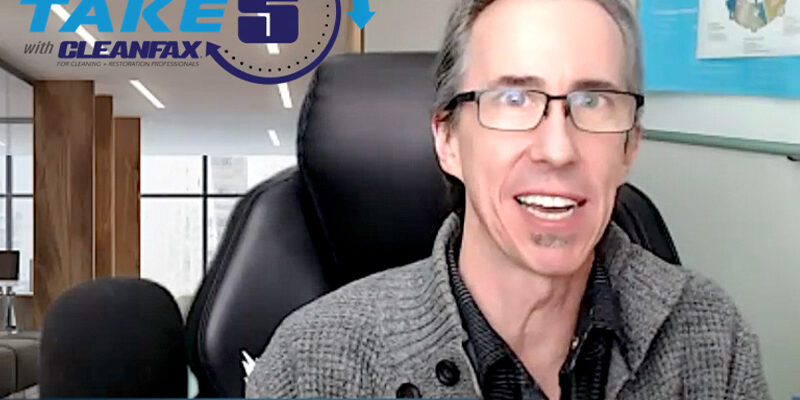Ice Dams: Formation, Prevention, and Mitigation
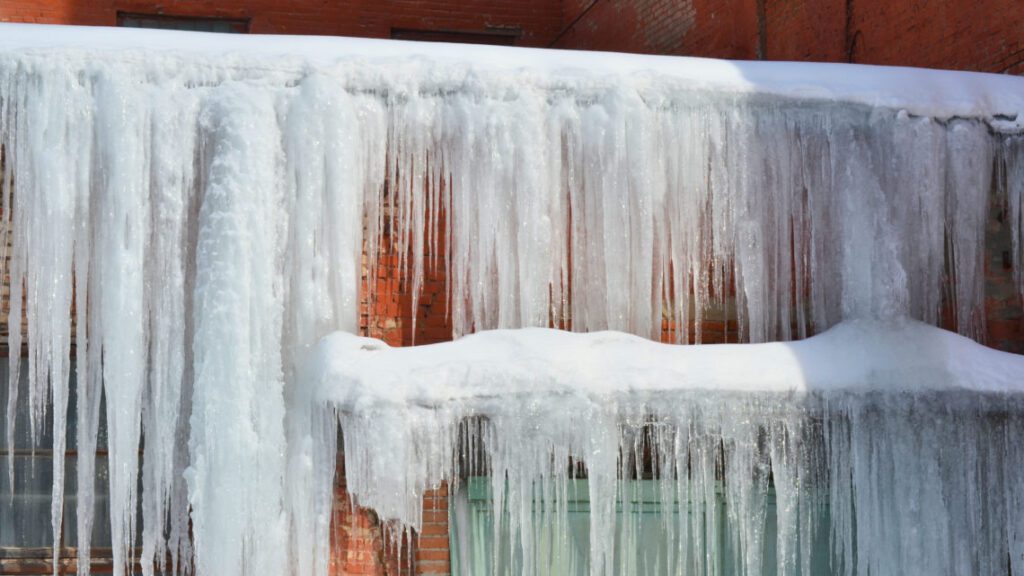
By Dan Parker & Rachel L. Adams
Introduction
As we approach the cooler change of seasons, we look forward to many things; the stunning change of foliage, football, and atmospheric water vapor frozen into ice crystals and falling in light white flakes, more commonly known as snow.
If you live in the north, you’ve probably had anywhere from a few inches to several feet of snow at one time or another. Regardless of your location, if you have experienced snow accumulation along with freezing temperatures and certain building conditions, you may have been the recipient of an ice dam as a cleaning/restoration company owner with a storefront property.
The term “ice dam” refers to the damming of water behind an accumulation of ice buildup along the eaves and/or valleys on a roof covered with snow. Heat loss from the business’ building into the attic space or rafter cavities warms the roof deck and causes snow to melt. When this snowmelt reaches the eaves, it freezes as there is no heat loss in this area. This can lead to a buildup of ice and a backup of water, hence the term “ice dam.”
This article reviews the cause(s) of ice dams, covers steps to prevent their formation, and discusses the mitigation of damage when an ice dam forms. We will also review ANSI/IICRC standards to determine the categorization of water from ice dams.
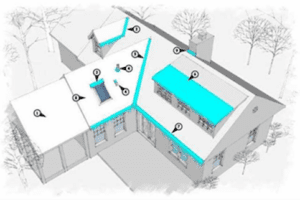
Figure 1 – Common locations on a roof where ice dams form.
Ice dam basics
There are a few key points that differentiate an ice dam condition from typical snow accumulation on a roof:
- The outside temperatures must be below freezing for a duration long enough to allow freezing at the roof edge to occur. An ice dam will not typically occur during early winter snow when outdoor temperatures are just beginning to decline, or they routinely move above and below freezing during the day.
- A large enough snowpack (mass of snow that is compressed and hardened by its own weight) must exist on the roof. If the snowpack on the roof is not substantial enough, as it melts, there may not be enough water to form the dam or become deep enough behind the dam to flow back into the building structure. Moisture can only enter by two means 1) If there is a hole, crack, etc., or 2) If moisture is moving through a material already within the loss structure or area. Typically, ice dams get in between the roofing materials and will enter between two joining ends of the oriented strand board (OSB) tongue and groove and/or opening, or by absorption into the OSB. In other words, the dam “flows back into the building structure.”
- A heat source must exist that warms the roof sheathing and melts the snowpack. This heat source is typically from the interior of the structure but can also be the result of solar radiation heating the snowpack. Ice dams can occur above the soffit ventilation as the cold/freezing wind forces its way into the attic space, cooling the back of the interior OSB.
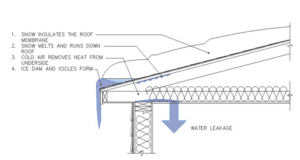
Figure 2 – Depiction of an ice dam with water infiltration.
Soffit ventilation
Ice dams are not as likely in early winter due to weather conditions that typically contain lower snowfall amounts and temperatures fluctuating between 20 and 30 degrees. In contrast, later winter months are more conducive to the conditions that result in an ice dam. One example occurred in February of 2010, when Pittsburgh, Pennsylvania received upwards of 24 inches of snow during a three-day period. The temperatures during that snow, and for two weeks afterward, stayed in the low 20’s to teens (can we just say below freezing?). As a result, numerous structures throughout the greater Pittsburgh area experienced ice dam issues.
Of course, geographically, weather conditions vary greatly and as a result, the frequency and magnitude of ice dams will vary as well.
Prevention
Obviously, since snow and colder temperatures are still regularly occurring weather conditions, the answer to preventing ice dams lies in good building design and building maintenance such as insulation inspection and OSB inspection.
Structures come in all shapes, sizes, and uses. For this article, a typical wood-framed residential home will be used as the model for the discussion. Since many companies opt for residential homes with the ability to be storefronts as well, this is an ideal example. The following are some contributing factors that increase the likelihood of ice dams as well as potential solutions.
Lack of sufficient insulation
Attics must be properly insulated to minimize heat loss from inside the building to the attic space in the winter. The use of insulation greatly slows heat loss, which is the reason building codes require certain R-values (the temperature difference between the warmer surface and colder surface of a barrier) based on geographic location. Colder areas typically require more insulation in the attic. The premise behind the insulation is to create a blanket in the attic to keep the heat inside the house and keep the cold air in the attic.
Additionally, air leaks and poor insulation can allow heat to quickly escape into the attic space. Figure 1 above shows that the insulation does not extend over the exterior wall plates. This condition can allow heat to easily migrate into this area, thus warming the roof sheeting.
Solution: Be sure that the proper amount of insulation is installed so it does not allow for these conditions at roof/wall intersects and at ceiling penetrations (recessed lights, HVAC devices, etc.).
Lack of adequate attic ventilation
By not having sufficient attic ventilation, warm air from inside the structure will migrate into the attic and become trapped, which then warms the underside of the roof sheeting. Like insulation requirements, the building codes also require ventilation of attic space. The code requires one square foot of net free area per every 150 square feet of attic space (for example a 1500 square foot attic space will require a minimum of 10 square feet of net free ventilation). Ideally, 50% of the ventilation would be placed along the ridge of the roof and the remaining 50% would be installed along the eaves. This would give 5 square feet of intake air into the attic at the eaves and 5 square feet of exhaust at the ridge.
Solution: Properly installed and sized attic ventilation (soffit and ridge vents) will provide airflow that removes warm air from the attic before it accumulates.
Air leakage
Similar to the lack of insulation, air leaks from the interior of the home also introduce warm air into the attic. A common location of air leaks is at pull-down attic stairs or around light fixtures in the ceiling. Heat from the interior can quickly escape into the attic space in these areas.
Solution: Seal any penetrations into the attic space, insulate recessed light fixtures, caulk and/or foam around electrical, plumbing, or HVAC penetrations, and seal and insulate attic access doors.
Heat sources in attic spaces
Any device that generates heat and is installed in the attic has the potential to warm the attic space and the roof sheeting. Furnaces are typically installed in the attic with poorly insulated supply ducts. Light fixture housings are also commonly installed in ceilings and the insulation is pulled away to facilitate installation (experts refer to heat movement as the stack effect). These conditions can increase the heat in the attic space.
Solution: If possible, eliminate heat sources from the attic space. If there is an air handler or supply ducts in the attic, ensure that no air leakages exist at duct connections, and/or appliance covers (this is to include fowl and/or rodent damage). Then, insulate all ductwork for heating and exhaust devices. Duct connection is done by heating, ventilation, and air conditioning (HVAC) tape regardless of duct materials. Light fixture housings should be insulated (some fixtures become extremely hot and do not allow insulation to be in contact with the fixtures—replacing these hot light sources with LED or fluorescent lights can allow the fixtures to be properly insulated. Refer to the manufacturer’s requirements or contact a qualified electrician for these types of conditions).
Snow thickness
At times, due to wind direction and intensity, it is possible that snow can be blown from the upper portion of the roof and expose or lift the shingles. Conversely, if snow catchers are installed at the base of the roof to hold back sliding snow, an accumulation of snow will occur at the base of the roof. When the roof is heated by solar radiation, the upper roof will warm faster, causing the snow to melt and flow down the roof slope. The lower roof, which is insulated by the snowpack, will not heat as quickly.
Solution: Removal of most of the snow from the roof surface is key, or at least reducing the thickness, which will help prevent variants in the snow thickness and allow for even melting. Snow does not melt evenly; rather, it melts based on the energy that is applied to the snow. For instance, if a tree or another object is blocking the snowbank, it will not melt evenly and will require extra attention from the owner and/or maintenance crew.
Mitigation
When water is entering through a ceiling of a residence (possibly from an ice dam), clients commonly ask about how to mitigate the resulting damage from an ice dam condition. Typically, snow will not “pour” into a building; rather, it will become absorbed or will collapse the roof with its weight. The solution to this problem is actually very simple—remove the water source. However, the execution of the solution can present some challenges and safety concerns during removal.
Removal of the water source, the snow, will eliminate the potential for the ice dam to grow and it will also eliminate the potential for water to back up under the roofing material and ultimately enter the structure. While easy in theory, the removal of snow from a steep, icy, and snow-covered roof is dangerous work. Professionals who are familiar with working in these conditions should be engaged. In addition to the dangerous conditions mentioned above, the weight of several feet of snow, combined with shovel-wielding workers bouncing on a roof, could lead to a sudden roof collapse.
If the means are not available to engage a professional service firm, a roof rake can be used by property owners. This tool can assist in the removal of snow from the roof while the operator stands safely on the ground.
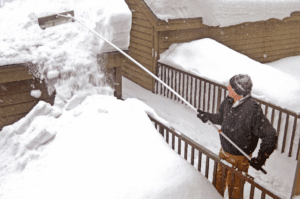
Figure 3 – Example of a roof rake being used to remove snow accumulation.
If the snow cannot be removed, what should be done? Let’s first discuss what not to do.
- Do not remove the gutters. While removing the gutters may eliminate some of the ice dams, it typically removes only the bottom portion of the dam. The upper portion at the eave still exits. Plus, it is dangerous to attempt to remove a frozen chunk of gutter that is several feet in the air.
- Do not break the ice dam up with an ax, hammer, or other tools of destruction. Hitting ice adhered to frozen, brittle shingles or in a gutter is a sure way to damage the existing structure materials. Common damage incurred includes cuts, punctures, and displacement of the material. When the ice begins to melt, water may pour into the structure through the holes created by the physical removal of the ice dam.
- Do not apply salt or calcium chloride to the ice dam. This may work in theory but likely will not work if the snowpack still exists above the melted remnants of the ice dam and the exterior conditions stay the same. Additionally, placing these products on roofing materials can cause immediate and/or long-term damage to the existing structure materials.
- Do not open up the ceiling where the water is leaking into the structure. Building owners and contractors alike tend to do this. The rationale is that because the ceiling and insulation are wet, mold will grow. Earlier in this article, the warming of the roof deck from rising heat was discussed as a contributing factor to ice dams. Opening a ceiling, removing the insulation, and allowing large amounts of warm air to impact the roof sheeting will not help the situation at hand. Opening the ceiling after the ice dam event is over, for the year, would be a plausible solution.
What should be done when experiencing water infiltration from an ice dam event and being unable to remove the water source?
- Do control what is being wetted. Often, the water does not spread over a large area. It tends to find the path of least resistance, say along a truss chord then through a hole in a ceiling from a plant hook. The best response to this type of situation is to place a bucket in a position to catch the water. Other times, the water may leak into the structure at multiple locations, such as the ceiling of a window. If the leak is minor enough, simply place towels in a position to absorb the water, exchanging them with dry towels as needed. Bear in mind that if the towel or bucket sits long enough it will produce malodor, and a damp or wet towel sitting on porous materials can lead to microbial growth, creating additional issues. In some cases, access to the ceiling may be required to drain the water. If necessary, make a small hole to drain and direct the water. Do not make the hole larger than needed as this could make the condition worse by allowing additional warm air to enter the structure.
If the water intrusion is not minor, then a professional mitigation company may need to be contacted to provide a dry-out of the wetted materials. If there is moisture intrusion, and weather permits, a roofing contractor should be contacted first, so they can identify and possibly eliminate the problem area. Then an appropriate mitigation contractor can be contacted. If you are a restoration contractor, you can simply learn the steps in order to mitigate these problems yourself and offer this service locally to other company owners in the future.
Water Categorization
As the contractor is often times the first onsite they will give a recommendation to a category of water from an ice dam event. Although not specifically defined in the current edition of the ANSI/IICRC S500, Standard and Reference Guide for Professional Water Damage Restoration, (S500), water from an ice dam that enters a structure could be placed into either of the three categories depending on the situation.
The categories of water, as defined by the current S500 document in Section 10.4.1, refer to the:
- Range of contamination in water.
- The water’s origin/source and its quality after it contacts materials present on the job site.
We can know and consider snow as “clean” water, as its source is the sky, but this water has come into contact with other snow, ice buildup, roofing tiles, and the roofing moisture barrier. The ice dam produces moisture between the barrier, or through the install holes (nails, staples) that allow the moisture to migrate between various openings (cracks, nail holes, wood knots, etc). - Time and temperature, which can increase/decrease the amplification of contaminants, thereby affecting the water’s category.
This is where there is a potential concern, as processes described above can lead to microbial growth and contamination of the moisture/water.
Restorers should consider the possibility that contamination has occurred. Contamination in this case is defined as the presence of undesired substances—the identity, location, and quantity of which are not reflective of a normal indoor environment—which can produce adverse health effects, cause damage to structures, systems, or contents, and/or adversely affect the operation or function of building systems.
Some say these categories are for human or animal (living) safety and health; however, they are in fact reflective of the build itself, its materials, assemblies, contents, and any products.
Category 1 Water
The S500 defines melting ice and snow as part of category 1. In theory, if the water does not contain any contaminants or additives that may be picked up while melting and/or being absorbed by building materials, then it could be classified as Category 1. These conditions would most likely not occur with an ice damming condition.
It is important to note that, if, for instance, a building’s supply line ruptures (which is Category 1) and the event affects asbestos materials that have to be removed, the situation is still considered a Category 1 with the presence of regulated material.
Category 2 Water
The S500 does not discuss melting ice and snow in category 2. It states that category 2 “contains significant contamination and has the potential to cause discomfort or sickness if contacted or consumed by humans.” Because of the potential to contain contamination as the result of flowing through building materials, category 2 appears to be the best definition of water that enters a structure from an ice dam and does not contain a significant hazard.
To elaborate, snow and ice melt will move through the OSB pores where there exists wood and glue (glue is not porous). It then weeps onto the insulation, where it is absorbed, and often will stay in place due to felt paper (with alumina backing), preventing any further movement. If there is long-term exposure to the intruding water, the insulation would eventually lose its ability to adsorb more water and allow for the moisture to flow to the drywall ceiling below. Drywall would then adsorb or absorb the moisture (it is porous); the water would then stay as the paper layer prevents it from moving further or allows it to become a stain. With enough weight accumulated, this water could cause the drywall ceiling to fail or collapse. Again, the water itself is not presenting the danger; rather, it is the structural materials. Therefore, intruding water should not be touched or ingested, and using PPE is recommended when handling these situations.
Category 3 Water
The S500 again does not discuss melting ice and snow in category 3. By definition, Category 3 water “is grossly contaminated and can contain pathogenic, toxigenic, or other harmful agents (fungi, bacteria, etc.) and can cause significant adverse reactions to humans if contacted or consumed.” It is important to note that this category only applies to the degree of biological contamination. In the definition of categories, the presence of regulated materials such as asbestos, lead, and even mold fall under a specific paragraph in the S500 that addresses those specific materials because they may require a specialized expert to test, remove, or sample.
Conclusion
Ice dams are a common issue for roofs in northern climates—most often occurring on eaves, though capable of occurring elsewhere—and they will continue to pose a challenge in terms of how to best manage the conditions that cause ice damming and/or fix the resulting damage. Company owners must take this into account and, if they are in the restoration industry, it may be valuable to take the time and courses to learn this form of water damage mitigation to expand your services during the slow season moving forward.
Good building design, maintenance, and code compliance are good practices for ice dam prevention; however, since the weather plays a crucial role in the frequency and severity of ice dams, building owners may not always have the final say when dealing with an ice dam condition.
About Dan Parker
Dan Parker is a Vice President in J.S. Held’s Building Consulting Practice. He is a roof damage expert specializing in damage assessment and forensic analysis of all types of roof coverings. Dan’s experience includes forensic analysis of a wide range of industrial, multi-family, commercial, transportation, educational, governmental, and residential projects throughout the country. In addition to Dan’s roofing expertise, he has extensive experience with damage assessment involving other types of losses such as fire, water, theft, vandalism, flood, and earthquakes. His knowledge of damage assessment comes from hands-on experience during his tenure with some of the world’s most respected companies including DSI, Allstate, CNA, and Haag Engineering just to name a few.
Dan can be reached at [email protected] or +1 470 287 3929.
About Rachel Adams
Rachel Adams is a Project Director in J.S. Held’s Environmental, Health, and Safety Practice. She specializes in indoor air quality and industrial hygiene and has more than 30 years of experience conducting indoor air quality investigations and serving as an expert witness for both plaintiff and defense cases. Rachel is an IICRC-approved instructor and served the cleaning and restoration industry by providing certification courses as well as participating in the ANSI-accredited IICRC standards for water damage and mold remediation. Rachel is involved in project management, and onsite project monitoring. She has extensive involvement in numerous major loss assignments throughout the United States and has consulted on large complex insurance losses, including malls, schools, and hospitals.
Rachel can be reached at [email protected] or +1 689 698 5258


